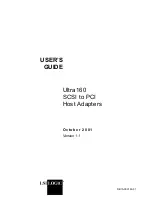
The disk identified by the first SCSI ID on the command line is assigned as the primary disk when
creating an IM volume. If the SAS controller is allowed to resynchronize the disks, the data on the
primary disk is available by accessing the newly created volume.
Using the AUTO Command
The
AUTO
command automatically creates an IM volume on the SAS controllers. The volume is
created with the maximum number of disks available for use in the specified volume type. The
main difference between the
AUTO
command the
CREATE
command is that with
AUTO
command,
the user does not specify SCSI ID values for disks to use in the volume. The
cfggen
utility uses the
first disks it finds that are usable in the IM volume. Firmware and hardware limitations for the family
of controllers limit the number of configurations that are possible.
Syntax
cfggen <controller #> auto <volume type> <size> [qsync] [noprompt]
Parameters
<volume type>
Volume type for the volume to be created. Valid value is IM.
<size>
Size of the RAID volume in megabytes, or “MAX” for the maximum size
available.
[qsync]
Quick synchronization of the volume created.
[noprompt]
Eliminates warnings and prompts.
Operation
When
AUTO
creates an IM volume, the first disk found is assigned as the primary disk. If the
controller is allowed to resynchronize the disks, the data on the primary disk is available by
accessing the newly created volume. Reply
Yes
to complete the creation.
HOTSPARE
The
HOTSPARE
command creates a hot spare disk. The hot spare disk is added to hot spare pool
0.
Syntax
cfggen <controller #> HOTSPARE [DELETE] <Encl:Bay>
Parameters
<controller #>
A SAS controller number between 0 and 255.
[DELETE]
Specifies that the hot spare is to be deleted. Omit the DELETE keyword to
specify hot spare creation.
<Encl>:<Bay>
Enclosure number and Bay number that identifies the disk that becomes the
hot spare.
Operation
The number of disks in an IM array plus the hot spare cannot exceed three. You can create only
one hot spare disk. Make sure the capacity of the hot spare disk is greater than or equal to the
capacity of the smallest disk in the logical drive. An easy way to verify this is to use the
DISPLAY
command.
See
“Rules for creating IM volumes and hot spare disks” (page 66)
.
Verify and Install the Latest Firmware
HP attempts to provide you with the most current version of firmware. However, there might be
instances when this is not the case.
Verify and Install the Latest Firmware
67
















































